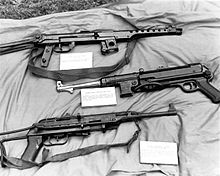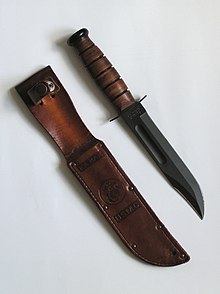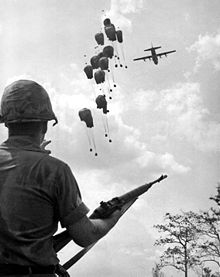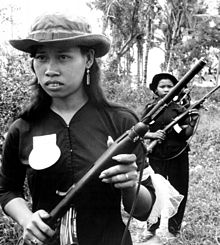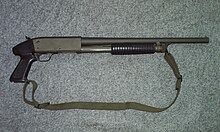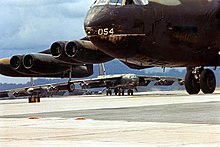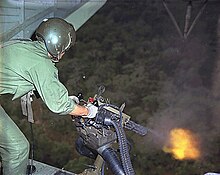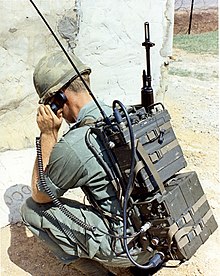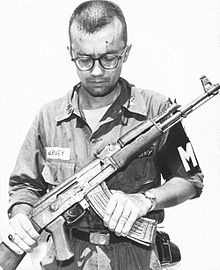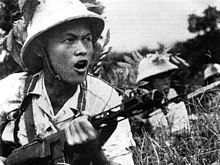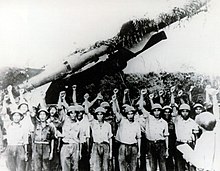
The Army of the Republic of Vietnam composed the ground forces of the South Vietnamese military from its inception in 1955 to the Fall of Saigon in April 1975. At the ARVN's peak, an estimated 1 in 9 citizens of South Vietnam were enlisted, composed of Regular Forces and the more voluntary Regional Forces and the Popular Force militias. It is estimated to have suffered 1,394,000 casualties during the Vietnam War.

The M1 carbine is a lightweight semi-automatic carbine that was issued to the U.S. military during World War II, the Korean War, and the Vietnam War. The M1 carbine was produced in several variants and was widely used by paramilitary and police forces around the world after World War II.

The M79 grenade launcher is a single-shot, shoulder-fired, break-action grenade launcher that fires a 40×46mm grenade, which uses what the US Army calls the High-Low Propulsion System to keep recoil forces low, and first appeared during the Vietnam War. Its distinctive report has earned it colorful nicknames, such as "Thumper", "Thump-Gun", "Bloop Tube", "Big Ed", "Elephant Gun", and "Blooper" among American soldiers as well as "Can Cannon" in reference to the grenade size; Australian units referred to it as the "Wombat Gun". The M79 can fire a wide variety of 40 mm rounds, including explosive, anti-personnel, smoke, buckshot, flechette, and illumination. While largely replaced by the M203, the M79 has remained in service in many units worldwide in niche roles.
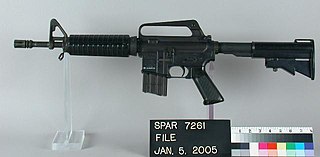
The Colt Automatic Rifle-15 or CAR-15 is a family of M16 rifle–based firearms marketed by Colt in the 1960s and early 1970s. However, the term "CAR-15" is most commonly associated with the Colt Commando ; these select-fire carbines have ultrashort 10.5-inch (270 mm) and 11.5-inch (290 mm) barrels with over-sized flash suppressors.

The Type 11 light machine gun was a light machine gun used by the Imperial Japanese Army in the interwar period and during World War II. Adopted as the Imperial Japanese Army's first light machine gun, the Type 11 was designed by Kijirō Nambu and had certain similarities to the Hotchkiss series of machine guns. It had an unusual feed system which required five round clips to be dropped into a hopper, this held up to a total of six clips and each round was oiled as it was fed into the chamber. Despite good overall performance, this feed system was prone to collect dirt and grit which would jam the weapon while in use. It was issued to troops in 1922 and saw extensive service as a squad weapon until 1945.
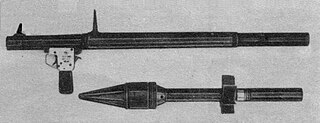
The RPG-2 is a man-portable, shoulder-fired anti-tank weapon that was designed in the Soviet Union. It was the first successful anti-tank weapon of its type, being a successor to the earlier and unsuccessful rocket-propelled grenade RPG-1.

The XM148 was an experimental 40 mm grenade launcher developed by Colt Firearms as the CGL-4. Colt manufactured the launcher for field testing during the Vietnam era. After problems with the experimental design were discovered, the XM148 was replaced by AAI Corporation's conceptually similar M203 design, which became the primary grenade launcher used by the US armed forces and others until its ongoing replacement with the M320.

The Type 89 grenade discharger, inaccurately and colloquially known as a knee mortar by Allied forces, is a Japanese grenade launcher or light mortar that was widely used in the Pacific Theater of World War II. It got the nickname the "knee mortar" because of an erroneous Allied belief that these launchers could be fired by propping its plate against the leg. However, anyone trying to fire it this way would receive a severe bruise from its hefty recoil.

The Vietnamese National Army was the State of Vietnam's military force created shortly after the Élysée Accords, where the State of Vietnam was recognized by France as an independent country ruled by Vietnamese Emperor Bảo Đại. It was commanded by Vietnamese General Hinh and was loyal to Bảo Đại. The VNA fought in joint operations with the French Union's French Far East Expeditionary Corps (CEFEO) against the communist Việt Minh forces led by Ho Chi Minh. Different units within the VNA fought in a wide range of campaigns including the Battle of Nà Sản (1952), Operation Hautes Alpes (1953), Operation Atlas (1953) and the Battle of Dien Bien Phu (1954).

The Army of the Republic of Vietnam Special Forces were the elite military units of the Army of the Republic of Vietnam (ARVN). Following the establishment of the Republic of Vietnam in October 1955, the Special Forces were formed at Nha Trang in February 1956. During the rule of Ngô Đình Diệm, the Special Forces were run by his brother, Ngô Đình Nhu, until both were assassinated in November 1963 in a coup. The Special Forces were disbanded in 1975 when South Vietnam ceased to exist after the Fall of Saigon.

The Cambodian Civil War was a military conflict that pitted the guerrilla forces of the Maoist-oriented Communist Party of Kampuchea and the armed and security forces of the Nonaligned Kingdom of Cambodia from 1967 to 1970, then between the joint Monarchist, Maoist and Marxist-Leninist National United Front of Kampuchea alliance and the pro-western Khmer Republic from 1970 to 1975. Main combatants comprised:

The Viet Cong and the North Vietnamese People's Army of Vietnam (PAVN) used well-organized logistics methods to supply and equip their fighting forces. This logistics organization helped greatly in their war against the American and South Vietnamese military during the Vietnam War.
The Salvadoran Civil War was a military conflict that pitted the guerrilla forces of the left-wing Marxist-oriented Farabundo Marti National Liberation Front (FMLN) against the armed and security forces loyal to the military-led conservative government of El Salvador, between 1979 and 1992. Main combatants comprised:

The Khmer National Army was the land component of the Khmer National Armed Forces (FANK), the official military of the Khmer Republic during the Cambodian Civil War between 1970 and 1975.

The Laotian Civil War was a military conflict that pitted the guerrilla forces of the Marxist-oriented Pathet Lao against the armed and security forces of the Kingdom of Laos, led by the conservative Royal Lao Government, between 1960 and 1975. Main combatants comprised:

The Republic of Vietnam National Police – RVNP, Police Nationale de la République du Vietnam or Police Nationale for short in French, was the official South Vietnamese national police force from 1962 to 1975, operating closely with the Army of the Republic of Vietnam (ARVN) during the Vietnam War.

Combat police force of the Republic of Vietnam

The Liberation Army of South Vietnam was an irregular military force established by the Workers' Party of Vietnam in 1961 in South Vietnam as the armed wing of the Viet Cong. In 1962, the People's Revolutionary Party of South Vietnam separated from the Workers' Party of Vietnam in terms of external appearance, openly directing the Liberation Army's military. Politically, the South Vietnamese Liberation Army was under the direction of the National Front for the Liberation of South Vietnam and the Provisional Revolutionary Government of the Republic of South Vietnam. The military forces from the North to the South of Vietnam, although collectively known as the Liberation Army of South Vietnam, still use the unit names, military badges and War flag of the Vietnam People's Army.

The 81st Airborne Commando Battalion was a unique special unit of the Vietnamese Rangers of the Republic of Vietnam Military Forces.
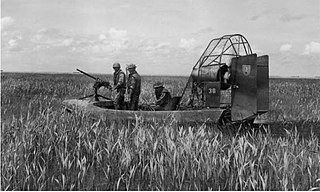
The Hurricane Aircat was an airboat used as a riverine patrol boat by the US Army and South Vietnamese Army (ARVN) during the Vietnam War. It was used to conduct various counterinsurgency (COIN) and patrol missions in riverine and marshy areas where larger boats could not go.

